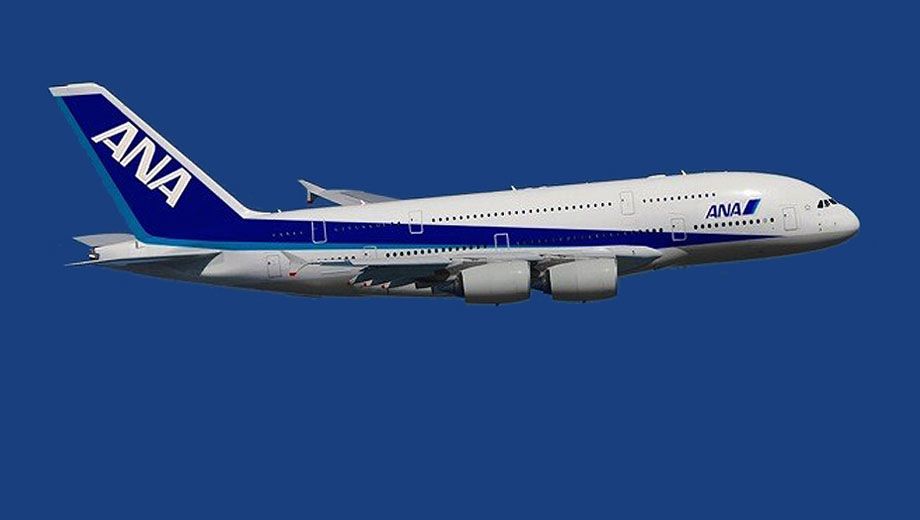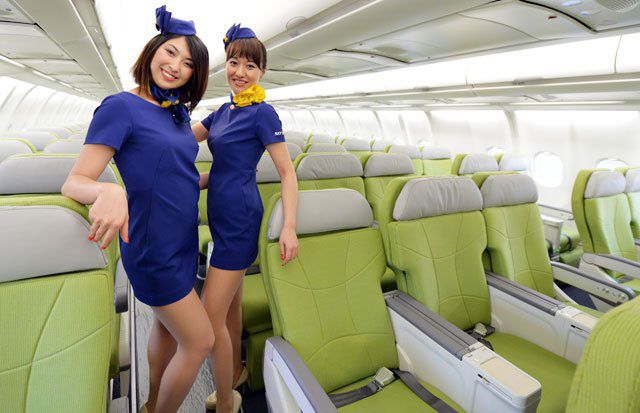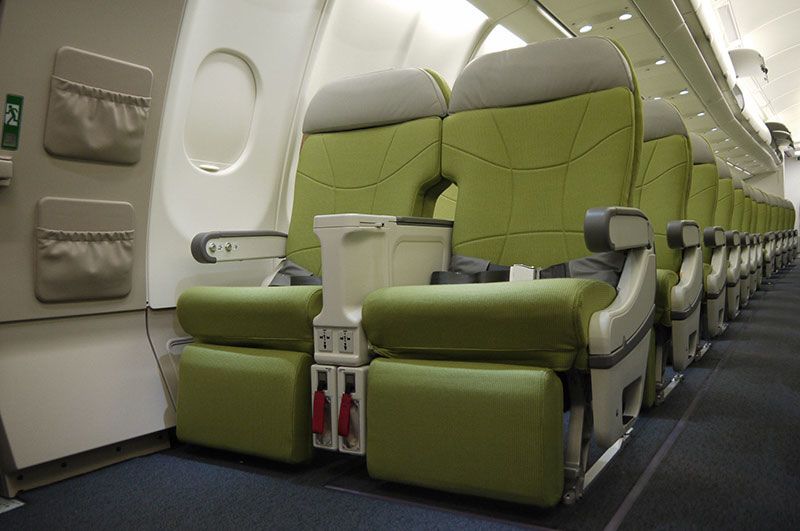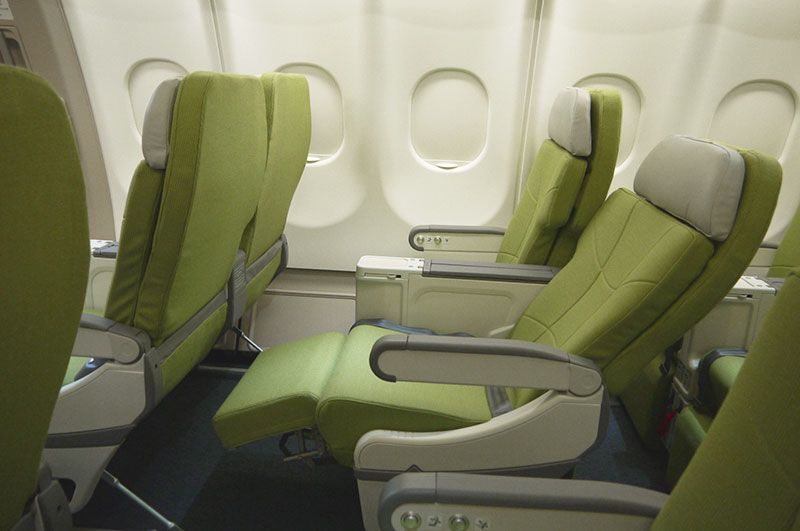ANA will become the first Japanese airline to fly the Airbus A380, with the Star Alliance member signing on the dotted line for three superjumbos due for delivery from 2018.
The double-decker jets, which represent a total list price order of US$1.3 billion, will be rostered onto the popular Tokyo-Hawaii route as part of a plan to expand ANA's international network.
ANA's order reportedly represents three of the six double-decker jets previously allocated to Japan's Skymark Airlines, which went bankrupt before it could take delivery of the jets in 2014.
The superjumbo that never flew
Skymark's A380 play called for an ambitious ‘all-premium’ seating plan married to low-cost fares to London and New York.
This includes an upper deck stacked with 114 business class seats, with 280 premium economy seats (shown below) lining the lower deck – but not an economy seat in sight.
Those premium economy seats where to be arranged in 2-3-2 layout with 40 inches of pitch, integrated leg rests for every passenger and shared AC power sockets.
The deal is an important win for Airbus, representing the A380's first new customer in three years.
Superjumbo orders have slowed as airlines lean towards fuel-efficient twin-engine jets such as the Boeing 787 – for which ANA was the global launch customer – the Airbus A350 and from 2020, the Boeing 777X.
Qantas has taken up only a dozen out of 20 ordered A380s, and there's little expectation within the industry that those remaining eight superjumbos will ever join the Flying Kangaroo's fleet.
Follow Australian Business Traveller on Twitter: we're @AusBT





Qantas - Qantas Frequent Flyer
12 Jan 2016
Total posts 2
I can see ANA ordering about 10 a380s by 2018, cant see them taking in more than 15 though
10 Dec 2015
Total posts 177
I can't see that even by 2028, let alone 2018. That's because the gauge size really fits poorly with NH's overall strategy & op circumstances @/near home. See below:
1) Relative to almost all foreign peers, NH has never chased volume and almost always prioritize yield/premium traffic=
We're talking about an operator that puts only 169/215 seats into its 788/789 configured for intercon routes. Except compatriot JL and BA(Though only on its 4-class 789), nobody else use such super-low density cabin along with an unusually low Y seat count on a 787.
2) U can't really replicate the low-density cabin approach on a 380 and still expect most premium seats will be filled @ a remotely similar fare=
NH's longhaul 789 has 48 J seats(No F). Given that a 380 more than double the usable cabin floor area of a 789, a NH 380 in similar density is gonna carry nearly 100 J seats(Or say 8F+80J). It's 1 thing to try to sell 48 premium seats on a flight but a completely diff mkting challenge to do the same for 90-100 premium seats everyday on the same route. It's extremely hard to increase corp/premium segment demand @ such magnitude regardless of what U do to your J fare(But U are NH so U won't do unsustainable J fare/yield). Nothing in NH fleet carries more than 68J today and actually very few(Probably just 77W x6) are beyond 52J.
3) Tweaking cabin density towards more Y on a 380 won't work for almost all NH intercon routes infested by loads of lower cost competitors=
NH has 1 of the world's highest unit cost(i.e. per seat/mile)...may be THE highest. There's so little room NH can discount Y before fare goes below unit cost(i.e. loss for every NH ticket sold) while most competitors can match NH's Y fare and still turn a profit. And we've not even started on the much larger mkting problem of how to sell 300%+ more Y seats on a 380 than the NH norm today in the notoriously price-sensitive Y segment.
4) NH's strategic priority is to up frequency for each continent, not consolidate/down frequency:
Look around the entire NH intercon network today(16 destinations), no destination get more than 2x daily and actually very few(Just FRA, JFK, ORD and LAX) are beyond a single daily service(The absolute minimum to capture any meaningful volume of corp mkt demand). When neighbors KE/CX already offer upto 3/4 daily frequency to mkts such as LAX, NH clearly needs more planes, not larger planes.
5) NH intercon network is build around 2 hubs, not 1 and will stay that way for decades to come=
HND: 380 ops are banned except the 22:00-06:00 zombie hours. Little to no chance to expand significantly for NH to consolidate all ops in this hub because new rwy build on the sea will be extremely costly but offer little extra slots thx to airspace restriction around HND. Theoretically if that no-fly zone is completely gone, HND can nearly double its current slot capacity overnite without building a single new rwy. In practice however, there're over 2m population living directly under that no-fly zone so it's likely a political suicide for anyone trying that theory on HND. Aside fm Tokyo's corp/premium OD mkt, this place works best to connect NH domestic with NH intercon.
NRT: Precious few NH domestic connecting opportunities there. Curfew 22:00-06:00 but no 380 ban outside curfew. Corp/premium segment demand to/fm local Tokyo mkt avoid this place(And its long commute) whenever an alternative exists @ HND(Luckily, there aren't many thx to HND limitations). Aside fm Tokyo's lower-yield OD mkt, this place works best to connect NH E.Asian network with NH intercon/Trans-Pcf.
So NH is stuck with a splitted hub intercon model which is unfriendly to build scale to feed even just a small fleet of five 380s, let alone 10. Hv U noticed that extremely few 380 operators hv actually got more than 1 intercon hub? If they've 2 or more intercon hubs, they either:
A) Taken delivery of fewer 380 than they've originally confirmed as firm order AND ceased/delayed further delivery. i.e. LH & QF hv less, not more, need for 380 than originally envisioned.
B) Hv a fleet of 5 or less. i.e. CZ has no plan to go beyond 5 despite CZ being the largest in China AND rapidly growing its intercon network in recent yrs.
The way I see it:
NH Holdings will take 3(All came fm the failed Skymark deal) and Airbus will be real lucky if NH adds 2 more 10yrs fm now(2026). All 380s @ NH Holdings will NOT be operated by NH but by its LCC subsidiary. The most likely candidate being Vanilla as it's already based @ NRT and its long term plan always envisioned widebody ops(Though initially planned yrs ago to be 333 or 763ER). The trio will be deployed daily 1st in HNL and then may be OKA to improve utilization(NH itself will exit these mkts fm NRT). GUM and/or DPS may be added later @ less than daily frequency and that's it....all are low-yield, leisure-heavy volume mkts popular for Japanese vacationers. These are also niche routes where Vanilla can actually match competitors' unit cost for HNL & GUM(All competitors are FSC), OKA(All competitors are Japanese LCCs) and only 1 competitor for DPS anyway(GA). All 380s will be configured with no J but only PY & Y+ upstairs and Y on main deck(a la JetStar and Scoot) so yes, we'll be looking @ 600+ seats each.
The only problem: OKA, GUM and DPS are possibly not yet certified for 380 ops.
12 Dec 2012
Total posts 1022
What HND no fly zone?
There is an overnight limit requiring flights come in over the bay, but I'm not aware of any such limit for day flights. I've seen many flights heading to/from HND go all over Tokyo during the day.
10 Dec 2015
Total posts 177
<<What HND no fly zone?>>
Unless U know HND geog orientation & op procedure very very well(I use HND @ least 6x per yr on avg and sometimes simply drive to the park nearby across the river to observe HND flight actions), it's pretty technical & complex so bear with me.
Bascially the entire airspace /theoretical flight path below cruise altitude over land on the:
A) N.West side starting fm the airport perimeter @ the end of rwy 34L. It means all take-offs fm 34L vectoring N.West or landings on 16R & 16L vectoring S.East are prohibited 24hrs a day/365days a yr. Take off fm 34R(i.e. the one right nex to Tokyo Bay on the east side facing Chiba) is allowed but all flights must bank starboard side pretty much immediately after wheels up to avoid the no fly zone.
B) S.West side starting fm the airport perimeter @ the end of 22 & 23. It means all take-offs fm 22 & 23 vectoring S.West or landings on 05 & 04 vectoring N.East are prohibited 24hrs a day/365days a yr.
A) and B) and their predecessor rwys in same layout hv been enforced for @ least 4 decades. This is the main reason why despite having 4 rwys, HND can generate much fewer slots than the pair @ LHR.
<<flights heading to/from HND go all over Tokyo>>
Simply not true. It may appear so to your eyes as many vantage/spotting points give such illusion. For any flights approaching/departing HND, the closest flight path over Tokyo skirts across the southern shoreline of Tokyo & Chiba(e.g. Disneyland) until near cruise altitude. All other allowed flight paths go over Tokyo Bay far fm land.
All these hv nothing to do with the day and night op regimes @ HND.
For more details re airspace restriction there, start with wikipedia re Haneda.
21 Jul 2012
Total posts 128
No way. As FLX has explained already, these planes aren't really a good fit for ANA. They're only taking them as part of the deal to acquire Skymark and its valuable HND slots.
What's interesting is the news this week that ANA will have F on these planes. That's not what you'd expect for a plane serving leisure routes. I wonder if they're also considering putting the plane on some North American routes, either consolidating destinations with multiple frequencies like ORD or upgauging a 77W at LAX or SFO. They're in a new joint venture with United for TPAC traffic, which presumably is helping to fill the planes with connecting traffic to Asia.
Qantas - Qantas Frequent Flyer
02 Jul 2011
Total posts 1377
And still no news on the A380s that MH have up for sale - not much of a second hand market.
Qantas - Qantas Frequent Flyer
15 Dec 2014
Total posts 284
This has been the rumour for quite a while now. From my understanding they are looking to configure it in a High Density Configuration mainly on Leisure Routes. TBH I don't see them taking more than 3 or 4 of them.
American Airlines - AAdvantage
13 Jul 2015
Total posts 275
Honestly, some of my best flying experiences have been with an A380 - the inside is super quiet as compared to other planes, which surprised me, so it's disappointing people are leaning away from the A380.
Another reasons is that despite lower fuel costs, Airlines still aren't passing on these savings to customers - and so people don't feel compelled to travel based on pricing, so A380's rarely go full unless it's holidays.
But looking forward to another company launching their A380!
10 Dec 2015
Total posts 177
<<...some of my best flying experiences have been with an A380...>>
I recall decades ago, folks flown on Concorde and to a much lesser extent, L1011(vs DC10) and VC10(vs 707), overwhelmingly made similar superiority remarks. Look where they or their descendants are today in the mkt.....
<<...disappointing people are leaning away from the A380>>
Nothing new nor suprisinig really as what U are really disapponted are:
1. At similar fare, vast majority of consumers choose convenience fm a) higher frequency and/or b) more direct routing bypassing fewer mega-hubs(Neither a) nor b) is friendly to a 380 op model) over the supposedly superior 380 inflight experience. Entrenched conventional wisdom(Thx to the media) explain the majority of travellers preferred the 747 decades ago because of its superior inflight experience. The cold truth is that the 747 was by far the only thing capable to bypass many stopover points on very long flights in its era....the experience just happened to be a bonus. The 380 no longer enjoys such convenience superiority today. Yes, it's disappointing that most folks are lazy and always look for the path of least resistance/effort.
2. Despite theoretical scale advantage, a smaller airplane in practice is cheaper to operate than a 380. This is because a smaller airplane, say a 787/350, is potentially good for far more routes, both higher or lower traffic demand routes, than a 380. Airlines accountant worry the most about unfilled seats on each flight but far less concerned about a flight doesn't hv enough seats to sell(i.e. comfortable with leaving demand unfilled). As always, airline accountants decide what airplane size to buy and naturally lean away fm behemoths such as a 380, not pax who lean toward a behemoth. When was the last time an accountant didn't disappointed U by being financially too practical/risk-adverse?
3. Easy to find pax to pay(Or an airline on how to charge) a premium only for more frequency/direct routing. Hard to find pax to pay(Or an airline figure out how to charge) a premium only for <<the inside is super quiet>> even if available only fm a 380. It's disappointing that today's consumer electronics tech can produce an equally quiet inflight experience via a cheap active noise-cancelling headset rather than aircraft engine makers to produce quieter 380 propulsion thru a multi billion $ R&D program....
<<...despite lower fuel costs, Airlines still aren't passing on these savings to consumers..>>
Simply not true for most carriers. Unless we've a memory lapse(I don't) typical among avg consumers, mandatory fuel surcharge on a typical longhaul flights(i.e. sectors of 8hrs & beyond) today is only about 40-50% of the level circa 2014....more or less aligned with global oil price trend.
<<A380's rarely go full unless it's holidays>>
Or unless that 380 is operated by EK(Along with its unique network strategy/model) and/or U are in DXB where holiday peaks seem to occur 365days per yr.
05 Sep 2014
Total posts 14
Does anyone know why the Tokyo Hawaii route is so popular on ANA? I've always been curious.
Air New Zealand - NZ*E
17 May 2015
Total posts 93
Several reasons - the main one being it's the closest US territory to mainland Japan where the Japanese people can get an authentic western experiance. Also there were a lot of Japanese immigrants who came to work in the 1800's in the sugar and pineapple plantations so there are also huge number of local family ties to Hawaii.
05 Sep 2014
Total posts 14
thanks!
10 Dec 2015
Total posts 177
<<...why the Tokyo Hawaii route is so popular on ANA?>>
Is that route truly <<so popular on ANA>> at all in the 1st place? Or hv I misread your comment/question?
NH launched NRT-HNL more than 2decades ago with a daily 763ER and didn't increased frequency nor gauge size until HND once again allowed int'l longhaul 5yrs ago when it added a daily 763ER on HND-HNL and hv stayed unchanged ever since. Over the same 20yrs timeframe, dozens of destination see 300-400% increase in frequency or capacity by NH.
If the Tokyo-HNL route has been truly <<popular>> for NH, I imagine capacity increase by NH there would hv been @ least closer to the level where other destinations hv been enjoying fm NH.
12 Dec 2012
Total posts 1022
People have been saying ANA will get 380s for months now, ever since Skymark first had debt issues.
If ANA was getting some 380s, why would it take ~2.5 years to get them? 2 of the frames meant for Skymark are all but complete. There are 4 sitting around in KUL ready for anyone who wants them. If ANA (or anyone) wanted some A380s, there are frames ready for operation within months, not years.
21 Jul 2012
Total posts 128
ANA doesn't really want the A380s. They took them as part of the deal to acquire Skymark. I imagine they're delaying as long as possible by saying they need 3 for fleet rotation or something.
21 Jul 2012
Total posts 128
Shouldn't someone from Perth have jumped in by now to say that PER could totally sustain daily A380 service to Japan?
Hi Guest, join in the discussion on ANA confirms Airbus A380 order, first flights in 2018